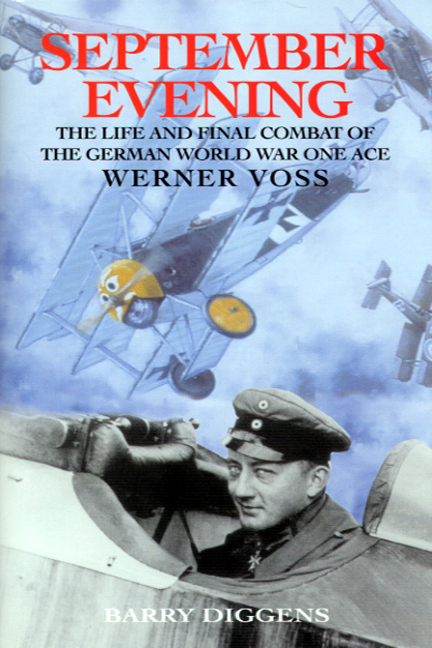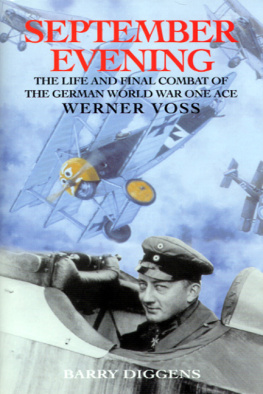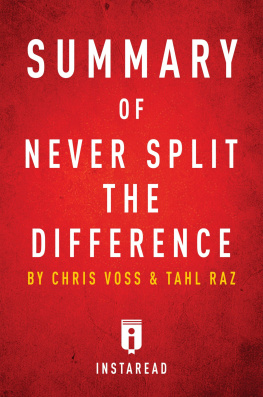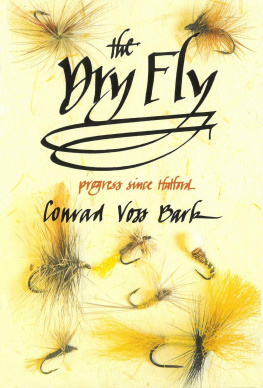

Published by
Grub Street
The Basement
10 Chivalry Road
London SW11 1HT
Copyright 2003 Grub Street, London
Text copyright Barry Diggens
British Library Cataloguing in Publication Data
Diggens, Barry
September evening: the life and final combat of
the German World War One ace Werner Voss
1.Voss, Werner, 1897-1917 2. Fighter pilots, German Biography
3. World War, 1914-1918 Aerial operations, German
I. Title
940.44944092
ISBN 1 904010 47 4
eISBN 9781908117878
All rights reserved. No part of this publication may be reproduced, stored in a retrieval system, or transmitted in any form or by any means, electronic, mechanical, photocopying, recording, or otherwise, without the prior permission of the copyright owner.
Typeset by Pearl Graphics, Hemel Hempstead
Printed and bound in Great Britain by
Biddles Ltd, Guildford and Kings Lynn
For three of Gods little miracles, my grandsons James, Samuel and Benjamin
CONTENTS
FOREWORD
There have been a number of works published on the life and death of the First World War German fighter pilot Werner Voss; most have appeared as short articles in journals and magazines, and as an occasional chapter in the memoirs of old-time aviators. However, there are three books dedicated to the subject that are worthy of note: the first, Rolf Italiaanders seminal German account Pour le Mrite Flieger mit 20 Jahren , is useful in as much as a good deal of the narrative can almost certainly be attributed to Oberleutnant Karl Bodenschatz, who served with Voss in 1917 and bore witness to his prowess in the air. Unfortunately this work is laced with a liberal helping of Nazi idealism that detracts somewhat from its worth as a serious study of the German ace. Almost a quarter of a century later, in 1962, the author-historian Walter Musciano offered Lt. Werner Voss, Germanys Greatest Teenage Ace , which in parts follows Italiaanders work, but also includes the service record of Voss, and a fairly accurate victory list, both published for the first time. Last, and by no means least, Dennis Hylands presented the aviation fraternity with what is arguably the best short vignette: Werner Voss , a scholarly work developed from an original article he wrote for the celebrated aviation journal Cross & Cockade (Great Britain), volume 6#3 (1975). These three works are important in their own right, and yet none ran to more than 7,000 words, and all contradict each other in matters of detail. The explanation for this is quite straight-forward, as the authors were not only breaking new ground in terms of original research, they were also bogged down by sifting fact from fiction, which was no easy task at the time. Werner Voss was something of an enigmatic figure, he was undoubtedly a loner, and very little is known of his early life, other than the fact that he was the son of a middle-class industrialist. In his short flying career, however, he came closest to outstripping Manfred von Richthofen as Germanys greatest ace.
From the British standpoint the circumstances surrounding the final combat between the Royal Flying Corps 56 Squadron and Voss on the evening of Sunday 23 September 1917 are well documented. Several renditions of the action are to be found in the combat reports of those British pilots who took part in the fight, the publications noted above, private correspondence and the eyewitness account of arguably Britains most famous fighter pilot, James McCudden, who wrote Five Years in the Royal Flying Corps . In the main, these accounts all provide substantially similar scenarios, yet all contain inconsistencies concerning aspects of that remarkable final combat that have been questioned over the last eighty odd years by eminent historians worldwide: vacillations and niggling doubts gave rise to a diatribe that continues to this very day. The German view is somewhat different, and in recent years there has been much pondering over the possibility that Voss actually survived the action and evaded his opponents, only to be shot down some time later that same evening. Unfortunately, what very little verifiable evidence there is to support such a theory, be it German or otherwise, is sadly fragmented. In part this is due to the fact that important documents relating to the life and death of Werner Voss have been lost: between August and November 1918 many units of the Luftstreitkrfte (the Imperial German Air Service) destroyed their records in the field, lest they fell into the hands of the advancing Allies. Accordingly, by the time those documents that did survive found their way to the German Reichsarchiv at Potsdam they were already seriously depleted. More than this, although it was fashionable for middle-class families to treasure personal correspondence in that bygone era, whatever Voss family papers there may have been were either destroyed in the Allied air-raids on Voss Rhineland hometown of Krefeld in 1943, or lost among the effects of close relatives in more recent times. Likewise, a number of official German documents relating to operations on the Western Front, among them many of the scarce war diaries and record books deposited at Potsdam, were destroyed during the bombing of the archive in 1944, else they were looted by elements of the Red Army after they blasted their way through the ruins of Berlin in the spring of 1945.
All told, this scarcity of corroborated evidence from the German side makes producing a well-balanced study of Voss an almost impossible task, and accounts for several highly romanticised incidents surrounding his life being published in books and journals in the last century that left much to be desired. Sadly, gaps in the fabric of evidence were all too often replaced by conjecture, supposition and what can only be termed unmitigated fictions, simply in order to pad-out an otherwise brief story. This has led to several inaccuracies being accepted as gospel in recent years. The net result is that present-day aviation enthusiasts are left with only thumbnail sketches of Voss early life, his enlistment in the military, his service on the Eastern Front, his period as a probationary pilot, and finally his untimely death at the age of twenty. An approach to the truth was certainly achieved by the authors noted above, because they took the trouble to do their homework, yet incredibly, whilst researching the subject several important pieces of the jigsaw puzzle were overlooked, forgotten or simply filed away for future reference. My own research has uncovered a scattering of these pieces that in some small measure brings us a little closer to the ultimate goal of presenting a factual rendition of the Voss saga.
Having said this, I make no claim to have produced a definitive study on the life and death of the young German ace, nor due to its incompleteness, can this work be classified as a biography in the truest sense of the word. Not long after beginning this project I came to the conclusion that I would only be able to offer a series of observations and commentaries on often controversial events that took place more than eighty years ago, events that nonetheless have become legendary in the annals of aviation history. If anything the purpose of this present study is to examine the fictions and get a little closer to the truth, to animate a new generation of enthusiasts and to stimulate further research on the subject. I am assured by friends and colleagues that fresh and recently rediscovered evidence presented within these pages will cause consternation among those who think they know all there is to know about the subject. Be that as it may, I ask only that my readers keep an open mind, and to those that will insist on nit-picking I say be my guest, find the inevitable errors that must occur here: infallibility is not among my gifts, so right the wrongs and add fuel to the debate. This will serve my purpose admirably, for I am mindful that this offering raises more questions than any answers it could possibly impart.











